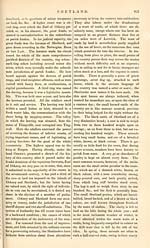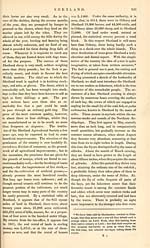Gazetteer of Scotland > Volume 2
(448) Page 928
Download files
Complete book:
Individual page:
Thumbnail gallery: Grid view | List view

928
SHETLAND.
supply of winter food, that the growth of the
summer herbage becomes necessary before
they can so far recover their strength as to bear
a rider over the moors of the country. These
hardy creatures are seldom more than nine or
eleven hands high, and can soon be made
ready for travelling. When a journey is medi-
tated, the Shetlander goes to the Scathold,
ensnares the unshod shelty, occasionally
equips him with a modern saddle and bridle,
and hangs on his neck a hair cord several yards
in length, well bundled up, from the extremity
of which dangles a wooden sharp-pointed stake.
The traveller then mounts his tiny courser,
his feet being often lifted up to escape the
boulders strewed in his way, and when arrived
at his destination, he carefully unravels the
tether attached to the neck of the animal, seeks
for a verdant piece of soil, and fixes the stake
into the ground. The steed is then considered
as comfortably disposed of, until his master
shall return. When manure is to be carried
to the fields, a klibbar, or wooden saddle, of a
peculiar form, is fixed on the back of each
shelty, to which cassies or straw baskets are
appended. The arable land generally preferred
for culture is described as sandy, or composed
of a mixture of clay and gravel that approaches
to a soft loam ; but often it consists of a
black mould resting on clay alone, or clay and
sand. Many of the enclosures near the
houses, or infield, have been dunged many
years, and have been sown in the end of April
with bear and oats for more than half a
century, without ever lying fallow, or having
produced a different kind of grain. The out-
field, or less productive parts, which are often
mossy and seldom drained, has also long re-
ceived each year a portion of dung, mixed with
duff-mould, earth, or sea-weed. The ground
is slightly harrowed ; it is then sown in the
end of March or beginning of April with black
oats. During the next season the outfield lies
fallow. The Shetland plough is rude, being
constructed with a single stilt only, and pulled
by four oxen abreast ; but for turning up the
land, the plough has been often laid aside, and
the ancient, slender, and long-shafted spade of
Shetland, which has a blade a quarter of the
breadth of the common garden spade of Scot-
land, and a convenient projecting piece of wood
for the application of the foot, is in much
greater requisition, being indeed well enough
adapted for the rugged and stony ground of the
country. The corn harvest of Shetland is
rarely finished till the end of October or even
November. The work of the husbandman is
frequently injured to a considerable extent by
the swine of the country, which appear to be
wild boars in miniature, or a race of little,
ugly, brindled rangers, not much larger than
terriers, too often suffered to roam abroad,
and destroy the fruits of the earth. The im-
perfect dikes, constructed of turf or stones,
easily yield to these animals, their efforts being
supported by wild shelties and sheep. In the
south of the mainland, rabbits have continued
to increase the desolation of the sand flood,
which there prevails. Instead of the growth
of plants, (which have a tendency to resist the
escape of the levigated particles of the subsoil,)
being encouraged, the reeds which grow among
the sand are still dug up by the roots, for the
laudable purpose of making besoms. The an-
cient quern, or hand corn mill, is still used in
Shetland. A machine of this description con-
sists of two staves about twenty-one inches in
diameter, resting on a kind of table. Near
the edge of the upper stave, there is a handle
which the grinder (generally a female of the
house) seizes and turns round with a sort of
centrifugal movement, whilst the left hand is
employed in supplying a hole in the centre
with corn. The meal then flies outwards, and
drops from between the staves on the table,
where it is every now and then scraped together
and taken away. Water-mills, probably as old
as the time of Harold Harfager, likewise ex-
ist. The grinding apparatus is of a very di-
minutive description, and is protected by a
low shed of unhewn stones, stretching across
one or other of the innumerable slender
rills which pour into the different voes.
The wild sheep of the country, of true native
breed, resemble in their form, their nimbleness
and fleetness, the argali, or wild sheep of Sibe-
ria. They are celebrated for their small size,
and known by naturalists under the name of
oves cauda brevi, which at the present day range
among the mountains of modern Scandinavia
and Russia ; in very few places are the Shet-
land sheep mixed with a Northumberland
breed. Their colour is exceedingly various,
being grey, black, dunnish brown, white, or
streaked and speckled in the most curious
manner with a combination of various tints and
shades. Besides the distinctive character which
they possess, from the shortness of their tails,
SHETLAND.
supply of winter food, that the growth of the
summer herbage becomes necessary before
they can so far recover their strength as to bear
a rider over the moors of the country. These
hardy creatures are seldom more than nine or
eleven hands high, and can soon be made
ready for travelling. When a journey is medi-
tated, the Shetlander goes to the Scathold,
ensnares the unshod shelty, occasionally
equips him with a modern saddle and bridle,
and hangs on his neck a hair cord several yards
in length, well bundled up, from the extremity
of which dangles a wooden sharp-pointed stake.
The traveller then mounts his tiny courser,
his feet being often lifted up to escape the
boulders strewed in his way, and when arrived
at his destination, he carefully unravels the
tether attached to the neck of the animal, seeks
for a verdant piece of soil, and fixes the stake
into the ground. The steed is then considered
as comfortably disposed of, until his master
shall return. When manure is to be carried
to the fields, a klibbar, or wooden saddle, of a
peculiar form, is fixed on the back of each
shelty, to which cassies or straw baskets are
appended. The arable land generally preferred
for culture is described as sandy, or composed
of a mixture of clay and gravel that approaches
to a soft loam ; but often it consists of a
black mould resting on clay alone, or clay and
sand. Many of the enclosures near the
houses, or infield, have been dunged many
years, and have been sown in the end of April
with bear and oats for more than half a
century, without ever lying fallow, or having
produced a different kind of grain. The out-
field, or less productive parts, which are often
mossy and seldom drained, has also long re-
ceived each year a portion of dung, mixed with
duff-mould, earth, or sea-weed. The ground
is slightly harrowed ; it is then sown in the
end of March or beginning of April with black
oats. During the next season the outfield lies
fallow. The Shetland plough is rude, being
constructed with a single stilt only, and pulled
by four oxen abreast ; but for turning up the
land, the plough has been often laid aside, and
the ancient, slender, and long-shafted spade of
Shetland, which has a blade a quarter of the
breadth of the common garden spade of Scot-
land, and a convenient projecting piece of wood
for the application of the foot, is in much
greater requisition, being indeed well enough
adapted for the rugged and stony ground of the
country. The corn harvest of Shetland is
rarely finished till the end of October or even
November. The work of the husbandman is
frequently injured to a considerable extent by
the swine of the country, which appear to be
wild boars in miniature, or a race of little,
ugly, brindled rangers, not much larger than
terriers, too often suffered to roam abroad,
and destroy the fruits of the earth. The im-
perfect dikes, constructed of turf or stones,
easily yield to these animals, their efforts being
supported by wild shelties and sheep. In the
south of the mainland, rabbits have continued
to increase the desolation of the sand flood,
which there prevails. Instead of the growth
of plants, (which have a tendency to resist the
escape of the levigated particles of the subsoil,)
being encouraged, the reeds which grow among
the sand are still dug up by the roots, for the
laudable purpose of making besoms. The an-
cient quern, or hand corn mill, is still used in
Shetland. A machine of this description con-
sists of two staves about twenty-one inches in
diameter, resting on a kind of table. Near
the edge of the upper stave, there is a handle
which the grinder (generally a female of the
house) seizes and turns round with a sort of
centrifugal movement, whilst the left hand is
employed in supplying a hole in the centre
with corn. The meal then flies outwards, and
drops from between the staves on the table,
where it is every now and then scraped together
and taken away. Water-mills, probably as old
as the time of Harold Harfager, likewise ex-
ist. The grinding apparatus is of a very di-
minutive description, and is protected by a
low shed of unhewn stones, stretching across
one or other of the innumerable slender
rills which pour into the different voes.
The wild sheep of the country, of true native
breed, resemble in their form, their nimbleness
and fleetness, the argali, or wild sheep of Sibe-
ria. They are celebrated for their small size,
and known by naturalists under the name of
oves cauda brevi, which at the present day range
among the mountains of modern Scandinavia
and Russia ; in very few places are the Shet-
land sheep mixed with a Northumberland
breed. Their colour is exceedingly various,
being grey, black, dunnish brown, white, or
streaked and speckled in the most curious
manner with a combination of various tints and
shades. Besides the distinctive character which
they possess, from the shortness of their tails,
Set display mode to: Large image | Transcription
Images and transcriptions on this page, including medium image downloads, may be used under the Creative Commons Attribution 4.0 International Licence unless otherwise stated. ![]()
| Gazetteers of Scotland, 1803-1901 > Gazetteer of Scotland > Volume 2 > (448) Page 928 |
|---|
| Permanent URL | https://digital.nls.uk/97436198 |
|---|
| Description | Volume II: Glenbanchor to Zetland. |
|---|---|
| Attribution and copyright: |
|
| Description | By Robert Chambers and William Chambers. Glasgow: Blackie & Son, 1838. 2 volumes. |
|---|---|
| Shelfmark | NF.1461.g.7 |
| Additional NLS resources: | |

